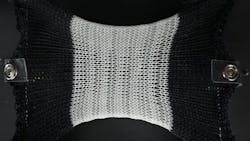Shape-shifting fibers expand and contract based on body temperature
I don’t know why, but I can never dress properly for the weather. Every time I’m getting ready for a night out, I check the weather forecast, step outside my front door to give my proposed outfit a test drive, and even ask friends what they’ll be wearing. Without fail, regardless of the temperature, I’m always cold. I always blame myself for not layering sufficiently, but the fault may be with my clothes and not me.
Researchers at MIT have created a new body-temperature shape-changing fiber. Based on liquid crystal elastomers, the FibeRobo fiber can be embedded or structured into textiles. The fiber is engineered to contract when heated by the wearer’s body or an external heat source. When the temperature decreases, the fiber self-reverses without the need for embedded sensors or other hard components.
In a recent paper, “FibeRobo: Fabricating 4D Fiber Interfaces by Continuous Drawing of Temperature Tunable Liquid Crystal Elastomers,” the team of researchers from MIT and Northeastern University writes, “Three definitive properties distinguish FibeRobo from other actuating fibers explored in HCI. First, they exhibit rapid thermal self-reversing actuation with large displacements (~40%) without twisting. Second, we present a reproducible UV fiber drawing setup that produces hundreds of meters of fiber with a sub-millimeter diameter. Third, FibeRobo is fully compatible with existing textile manufacturing machinery such as weaving looms, embroidery, and industrial knitting machines. This paper contributes to developing temperature-responsive LCE fibers, a facile and scalable fabrication pipeline with optional heating element integration for digital control, mechanical characterization, and the establishment of higher hierarchical textile structures and design space.”
The potential uses of this low-cost, innovative fiber are limitless. Imagine using a single coat throughout the year that can automatically adjust to temperature changes. Imagine owning bed sheets that expand to keep you warm in the winter without the need for blankets and duvets. Imagine a future where fashion is no longer bound to the whims of the weather.
In a recent quote, Jack Forman, a graduate student in the Tangible Media Group of the MIT Media Lab and the lead author of the paper, said, “We use textiles for everything. We make planes with fiber-reinforced composites, we cover the International Space Station with a radiation-shielding fabric, we use them for personal expression and performance wear. So much of our environment is adaptive and responsive, but the one thing that needs to be the most adaptive and responsive — textiles — is completely inert.”
About the Author
Alexis Gajewski
Senior Content Strategist
Alexis Gajewski has over 15 years of experience in the maintenance, reliability, operations, and manufacturing space. She joined Plant Services in 2008 and works to bring readers the news, insight, and information they need to make the right decisions for their plants. Alexis also authors “The Lighter Side of Manufacturing,” a blog that highlights the fun and innovative advances in the industrial sector.
